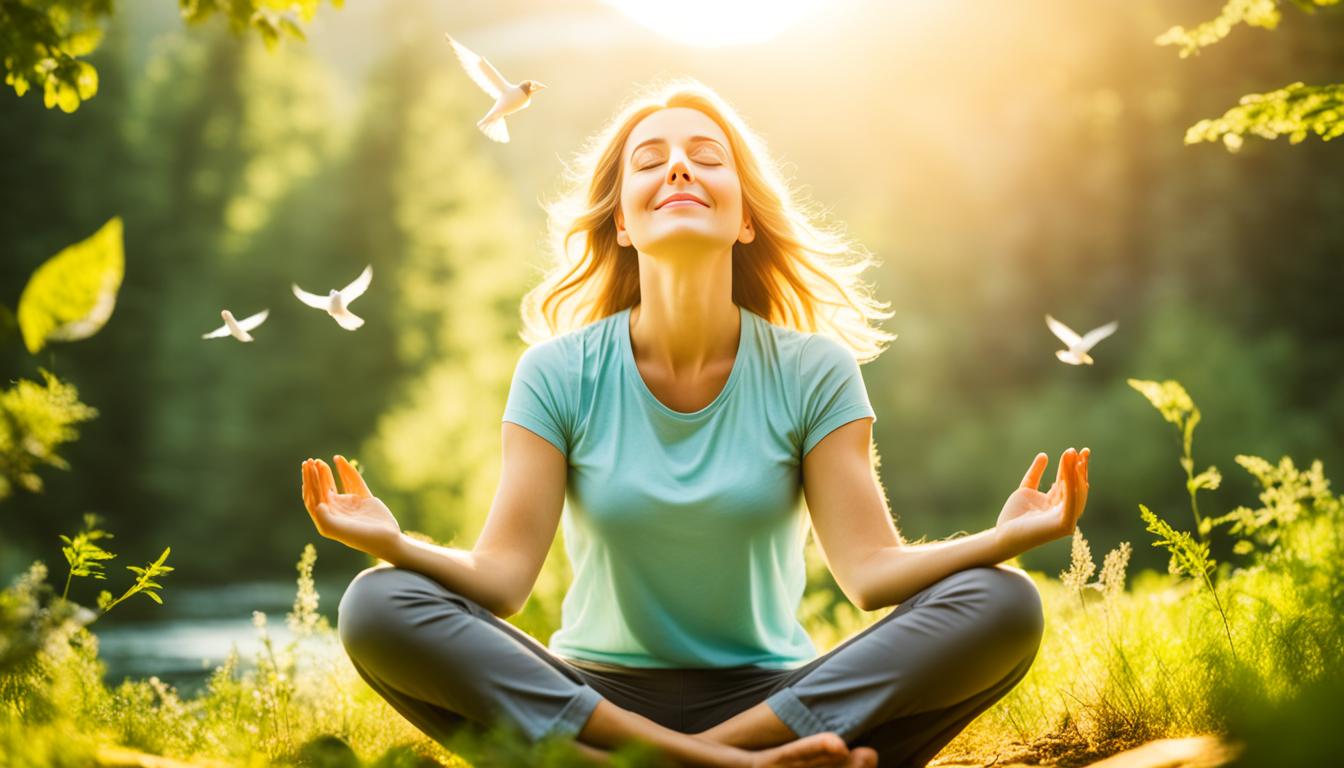Did you know that incorporating moments of calmness into your daily routine can have a profound impact on your mental health? In today’s fast-paced and chaotic world, finding peace of mind may seem challenging. However, by intentionally embracing periods of stillness, we can cultivate a sense of serenity and harmony within ourselves.
In this article, we will explore six practical ways to cultivate stillness and embrace inner peace. From harnessing the power of breath to embracing spontaneous moments of stillness, we will discover how to find tranquility amidst the noise and busyness of our daily lives. Are you ready to embark on this journey towards inner peace? Let’s dive in!
Key Takeaways:
- Practicing stillness can have a profound impact on our mental health and well-being.
- Incorporating moments of stillness in our daily routine can help us find inner peace.
- There are various practical ways to cultivate stillness, including focusing on the power of breath and embracing spontaneous moments of stillness.
- By creating structure, finding favorite stillness spots, and nurturing our spirit, we can deepen our practice of stillness.
- Prioritizing self-care and cultivating joy and fulfillment are essential in our journey towards inner peace.
The Power of Breath
When it comes to finding stillness and calm in our lives, we often overlook the power of our own breath. Deep breathing is a simple yet effective practice that can help us tap into the parasympathetic system, slowing down our heart rate and promoting a state of relaxation.
By taking slow, deep breaths, we activate the parasympathetic nervous system, which is responsible for regulating our body’s rest and digest response. This activation helps counter the effects of the sympathetic nervous system, which is responsible for triggering the fight or flight response. Through deep breathing, we can shift our body into a state of rest and relaxation, promoting a sense of stillness within.
Deep breathing can be practiced anywhere and at any time, making it a valuable tool for finding moments of stillness amidst the busyness of our lives. Whether we’re at home, at work, or on the go, taking a few minutes to focus on our breath can help us restore balance and calm our minds.
Here is a simple deep breathing exercise you can try:
- Find a comfortable position, either sitting or lying down.
- Close your eyes and take a moment to bring your attention to your breath.
- Inhale deeply through your nose, feeling your belly rise as you fill your lungs with air.
- Exhale slowly through your mouth, allowing any tension or stress to leave your body along with your breath.
- Continue this deep breathing pattern, focusing on the sensation of your breath as it enters and leaves your body.
- Take as many breaths as you need to feel a sense of calm and stillness.
By incorporating deep breathing into our daily routine, we can harness the power of our breath to practice stillness and promote a sense of inner peace. Let your breath guide you towards a state of calm and discover the transformative effects it can have on your well-being.
Embracing Spontaneous Stillness
When it comes to practicing stillness, spontaneity can be key. Regardless of our location, we can find moments to cultivate stillness and bring a sense of calm to our lives.
In the middle of a busy workday, taking a few minutes for ourselves can make a world of difference. Whether we’re in our office or any other place, setting aside time for stillness can help us recharge and regain focus. It allows us to step away from the demands of our schedule and connect with our inner selves.
Spontaneous stillness doesn’t always come naturally, especially in a fast-paced and hectic environment. In these cases, we can schedule moments of stillness and make them a priority in our lives. By setting aside specific times, we ensure that practicing stillness becomes a regular part of our routine. This intentional scheduling allows us to proactively create space for stillness, helping us restore balance and find a sense of peace amidst our daily demands.
Office Stillness Tips:
- Utilize short breaks: Take advantage of short breaks throughout the day to step away from your desk and engage in a brief stillness practice. A few minutes of deep breathing or quiet meditation can help reset your focus and enhance productivity.
- Create a designated stillness area: Designate a specific area in your office where you can retreat for moments of stillness. Whether it’s a cozy nook or a peaceful corner, having a dedicated space can signal to your mind and body that it’s time to pause, relax, and find stillness.
- Incorporate mindfulness exercises: Incorporate mindfulness exercises into your work routine, such as mindful walking or mindful eating. These practices can help bring your attention to the present moment, quiet the mind, and cultivate a sense of stillness.
By embracing spontaneous stillness and finding ways to incorporate it into our office life, we can create a sense of balance and inner peace amidst the demands of our schedule.
| Benefits of Spontaneous Stillness in the Office |
|---|
| 1. Increased focus and concentration |
| 2. Reduced stress and anxiety |
| 3. Enhanced creativity and problem-solving abilities |
| 4. Improved work-life balance |
| 5. Heightened self-awareness and emotional regulation |

Finding Favorite Stillness Spots
While practicing stillness can be done anywhere, starting at our favorite spot can enhance the experience. Whether it’s a park, a quiet bench, or a peaceful corner at home, being in a place that brings us joy and silence can help us find deeper stillness within ourselves.
Being outdoors offers a unique opportunity to connect with nature and find tranquility. Find a serene spot in a nearby park or garden, surrounded by the beauty of trees, flowers, and open skies. Allow the sounds of birds chirping and leaves rustling in the wind to create a peaceful ambiance.
Choose a secluded spot where you can feel connected to the natural world and away from distractions. This could be a hidden nook in a local forest, a peaceful beach, or a calm lake. Embracing the soothing sounds of nature can promote a sense of calm and aid in finding stillness.

If outdoors isn’t an option, create your own oasis of tranquility indoors. Dedicate a specific area in your home to be your sanctuary, where you can escape the noise and chaos of everyday life. Fill this space with comfortable cushions, soft lighting, and elements that bring you peace and serenity.
“In the midst of movement and chaos, keep stillness inside of you.” – Deepak Chopra
Remember, the key is to find a place that resonates with you and provides a sense of peace. It could be your favorite spot under a tree, a cozy nook in your garden, or even a balcony with a view. Prioritize finding silence and calm in your chosen location.
| Favorite Spots for Stillness | Description |
|---|---|
| A quiet park bench | A secluded spot where you can relax amidst nature, away from the hustle and bustle. |
| A peaceful garden | A tranquil space where you can unwind surrounded by beautiful flowers and greenery. |
| Your own meditation corner | A designated area in your home where you can create a peaceful atmosphere and focus on your stillness practice. |
Having a favorite spot dedicated to stillness can help create a sense of ritual and make it easier to incorporate stillness into your daily life. It provides a physical reminder to pause, breathe, and find inner calm.
Creating Structure with Music and Calming Phrases
Some people are afraid of being alone with their thoughts. In such cases, creating more structure can be helpful. Listening to soft, slow music or repeating calming phrases can give our stillness practice a sense of direction and support our journey towards inner peace.
Music has the power to transport us to a calmer state of mind. When we find ourselves struggling to quiet our thoughts, soft music can serve as a gentle backdrop, creating a soothing atmosphere that fosters relaxation and introspection. Whether it’s classical melodies, instrumental compositions, or nature sounds, the choice of music is a personal preference. Find what resonates with you and enhances your practice of stillness.
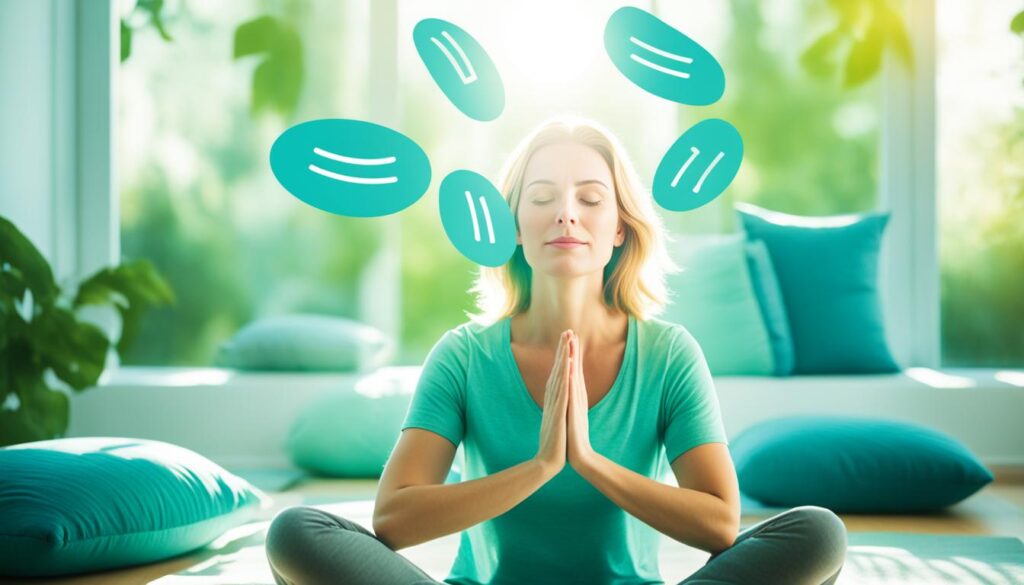
“Music is the literature of the heart; it commences where speech ends.” – Alphonse de Lamartine
Calming phrases, on the other hand, act as guiding mantras that anchor our minds and keep them focused during moments of stillness. These phrases can be simple yet powerful, bringing our attention back to the present moment and quieting the noise within. “I am calm and at peace,” “I embrace stillness with an open heart,” or “I release all tension and find serenity” are examples of soothing phrases that can accompany your practice.
Soft music and calming phrases provide a structure to our stillness practice, creating a supportive container that allows us to fully immerse ourselves in the experience. They help us maintain a sense of direction and provide gentle reminders to let go of distractions and worries. Experiment with different sounds and phrases to uncover what resonates with you, and allow them to guide you towards deep inner peace.
Stillness of the Mind
When it comes to finding inner peace, stillness begins within the space between our ears. Quieting the mind and bringing our focus to the present moment are crucial practices for achieving mental stillness. By letting go of distracting thoughts and cultivating non-judgmental awareness, we can create a sense of calm within our minds.
Our minds are constantly bombarded with a stream of thoughts, worries, and distractions. To practice stillness, we must learn to quiet this mental chatter and bring our attention to the present moment. This can be achieved through techniques such as mindfulness meditation, where we focus on our breath or a specific point of attention.
One effective method to quiet the mind is by observing our thoughts without judgment. Instead of getting caught up in the content of our thoughts or labeling them as good or bad, we can develop a non-judgmental awareness. This allows us to observe our thoughts from a distance, acknowledging their presence without attaching any significance to them.
“The present moment is the only time where we can truly experience stillness. By focusing our attention on the here and now, we can let go of the past and future, and find peace in the present.”
Practicing stillness of the mind involves training ourselves to let go of distractions and redirect our attention to the present moment. This may require patience and consistent practice, as our minds are naturally inclined to wander. However, with time and dedication, we can develop the ability to quiet our minds and find a sense of stillness within.
By incorporating practices such as mindfulness meditation and non-judgmental awareness into our daily routine, we can cultivate a deep and lasting sense of mental stillness. This practice allows us to detach from the incessant thoughts and worries that often consume our minds, and instead, embrace a state of calm and clarity.
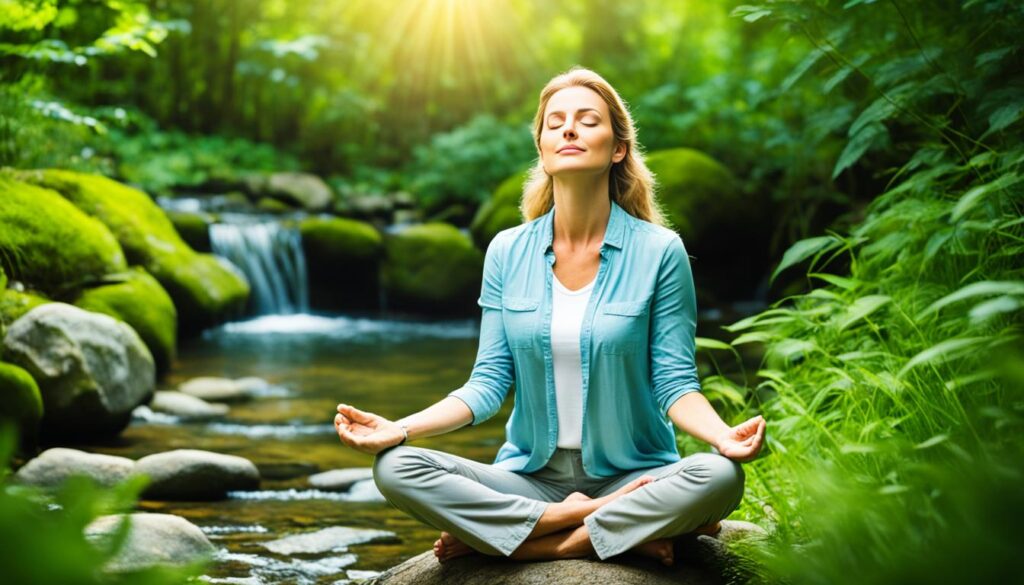
| Benefits of Stillness of the Mind | Techniques for Quieting the Mind |
|---|---|
|
|
With practice, the stillness of the mind becomes more accessible, even amidst the chaos of daily life. By cultivating a quieter mind, we can experience a greater sense of peace, clarity, and overall well-being.
Engaging the Spirit
Reflecting on our past experiences and engaging with our spirit can be powerful tools for personal growth and finding stillness. By delving into our past and examining the lessons we have learned, we can deepen our understanding of ourselves and the world around us.
In the journey towards stillness, it is important to question our beliefs and challenge any limiting thoughts or patterns. This process of self-reflection allows us to identify areas for improvement and growth. By acknowledging our defects of character and working on them, we can cultivate inner peace and align our spirit with our true purpose.
Celebrating our successes and learning from our mistakes helps us gain a sense of closure and resolution. It allows us to let go of past burdens and embrace the present moment with clarity and calmness. Engaging with our spirit and reflecting on past experiences fosters personal development, leading us towards a path of growth and transformation.
“To move forward, one must first look back.”

Benefits of Engaging the Spirit
Engaging with our spirit through reflection has several benefits:
- Provides clarity and insight into our past experiences.
- Fosters personal growth and development.
- Helps us identify patterns and beliefs that no longer serve us.
- Allows us to let go of regrets and find closure.
- Strengthens our connection to our inner wisdom.
- Aligns our actions with our values and purpose.
Reflective Questions
| Question | Benefits |
|---|---|
| What have I learned from past experiences? | Gains insight and wisdom. |
| What patterns or beliefs limit my growth? | Identifies areas for personal development. |
| How can I let go of past regrets? | Provides closure and emotional freedom. |
| What values and purpose guide my life? | Offers clarity and alignment. |
Engaging with our spirit through reflection allows us to navigate life with intention and purpose. By honoring our past experiences and using them as a catalyst for growth, we can cultivate stillness and inner peace.
Letting Go of External Comparisons
Focusing on others and constantly comparing ourselves to them can be detrimental to our journey towards inner peace. The practice of stillness requires us to shift our focus inward and let go of external comparisons.
When we constantly compare ourselves to others, we create a sense of lack and dissatisfaction within ourselves. It hinders our ability to appreciate and cultivate gratitude for our own unique strengths and experiences.
Letting go of external comparisons allows us to find contentment in the present moment and embrace the beauty of our own journey.
“Comparison is the thief of joy.” – Theodore Roosevelt
Instead of comparing ourselves to others, we can practice gratitude for the things we already have. Gratitude shifts our focus from what we lack to what we appreciate, fostering a sense of abundance and contentment.
Practicing gratitude can be as simple as acknowledging the small joys and blessings in our lives. It helps us recognize the value and uniqueness of our own experiences, promoting a sense of stillness and fulfillment.
Comparisons vs. Gratitude
| Comparisons | Gratitude |
|---|---|
| Leads to dissatisfaction | Fosters contentment |
| Focuses on lack | Shifts focus to abundance |
| Creates competition | Promotes cooperation |
| Generates negative emotions | Cultivates positive emotions |
| Stifles personal growth | Fosters self-acceptance and growth |
By practicing stillness and cultivating gratitude, we can break free from the cycle of comparisons and embrace our own unique journey towards inner peace. Letting go of external comparisons allows us to appreciate ourselves and others without judgment, fostering a sense of unity and compassion.
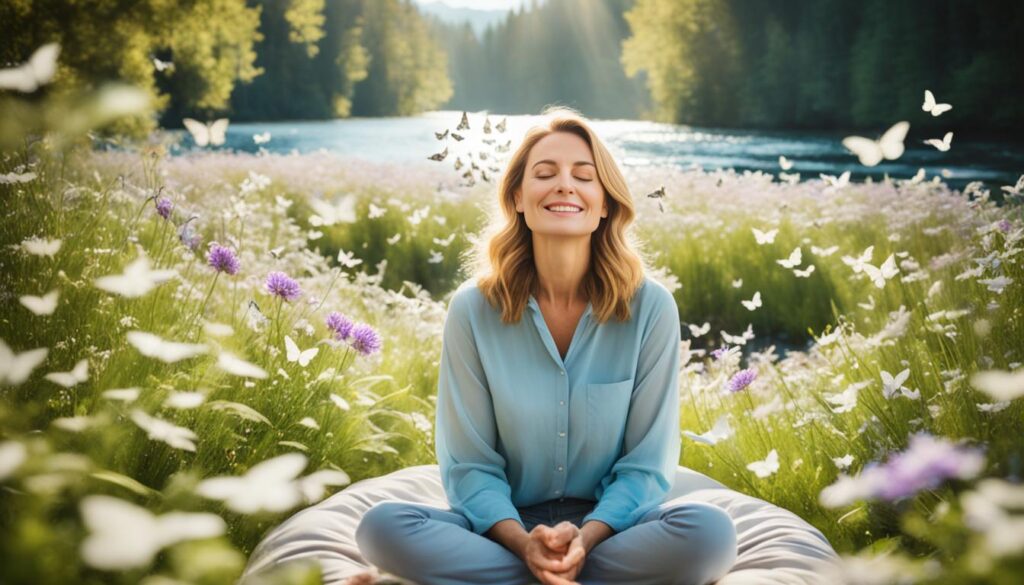
Nurturing Meaning and Purpose
Having a sense of purpose and meaning in life is essential for our overall well-being and can greatly contribute to our practice of stillness. Finding purpose gives us a sense of direction and focus, guiding us towards actions and decisions that align with our values and bring us fulfillment. When we have a clear purpose, it becomes easier to prioritize our time and energy, allowing us to let go of distractions and create space for stillness.
Finding meaning in our lives allows us to connect with something larger than ourselves, whether it’s our relationships, our work, or our contribution to the world. This sense of connection can bring a deep sense of calm and peace, as we realize that we are part of a bigger picture and that our actions have meaning and impact.
“The purpose of life is not to be happy. It is to be useful, to be honorable, to be compassionate, to have it make some difference that you have lived and lived well.” – Ralph Waldo Emerson
When we practice stillness with a sense of purpose and meaning, it becomes more than just a moment of quiet. It becomes a powerful tool for self-discovery, growth, and self-reflection. It allows us to tap into our inner wisdom and align our actions with our core values, leading us towards a more fulfilling and meaningful life.
Finding Meaning Through Reflection
Self-reflection is a powerful practice that can help us uncover our deepest values and passions. Take time each day to reflect on what truly matters to you. Ask yourself:
- What brings you joy and fulfillment?
- What impact do you want to make in the world?
- What are your core values?
By exploring these questions and reflecting on your answers, you can gain clarity on what gives your life meaning and purpose. This clarity will guide you in making decisions and taking actions that align with your true self, leading to a greater sense of inner peace.
Living with Intention
Living with intention is another powerful way to nurture meaning and purpose in our lives. When we live with intention, we make a conscious effort to align our actions with our values and goals. By setting meaningful goals and prioritizing activities that bring us closer to our purpose, we create a sense of purposeful direction in our lives.
“Don’t let the noise of others’ opinions drown out your own inner voice. And most importantly, have the courage to follow your heart and intuition.” – Steve Jobs
Living with intention means being mindful of how we spend our time and energy. It means saying no to activities and commitments that don’t align with our purpose, and saying yes to those that truly matter to us. By living with intention, we cultivate a sense of authenticity and fulfillment, creating a solid foundation for our practice of stillness.

| Benefits of Nurturing Meaning and Purpose in Stillness Practice | Actions |
|---|---|
| Enhances focus and concentration | Journaling about your core values and passions |
| Provides a sense of direction and clarity | Setting meaningful goals aligned with your purpose |
| Deepens self-awareness and self-discovery | Engaging in regular self-reflection practices |
| Fosters a sense of connection and fulfillment | Engaging in activities that contribute to a greater purpose |
Cultivating Joy and Fulfillment
Engaging in activities that bring us joy and fulfillment can have a transformative impact on our well-being. When we practice stillness and focus on the things that bring us happiness, we create space for inner peace and contentment to flourish.
By taking the time to engage in activities that bring us joy, we shift our focus away from stress and negativity. Whether it’s pursuing a hobby, spending time with loved ones, or immersing ourselves in nature, these moments of joy allow us to experience a sense of lightness and happiness.
When we practice stillness while engaging in joyful activities, we can fully immerse ourselves in the present moment. By being fully present, we can savor the joy and happiness that each experience brings, deepening our connection to the present and enhancing our overall satisfaction.
“The purpose of life is not to be happy. It is to be useful, to be honorable, to be compassionate, to have it make some difference that you have lived and lived well.” – Ralph Waldo Emerson
Practicing stillness and embracing joy also helps us cultivate a sense of gratitude. When we pause to appreciate the things that bring us happiness, we develop a deeper sense of gratitude for the abundance in our lives. This gratitude further enhances our sense of fulfillment and satisfaction.
To illustrate the profound impact of practicing stillness and joy, let’s take a look at the following table:
| Activity | Effect |
|---|---|
| Spending time in nature | Increases mood, reduces stress |
| Engaging in creative pursuits | Fosters a sense of accomplishment and fulfillment |
| Cultivating meaningful relationships | Creates a sense of connection and purpose |
| Practicing self-care | Enhances overall well-being and satisfaction |

As we can see from the table above, engaging in various activities that bring us joy and practicing stillness can have a profound and positive impact on our well-being. By prioritizing moments of joy and allowing ourselves to fully embrace them, we create a pathway to inner peace, happiness, and fulfillment.
Prioritizing Self-Care
When it comes to finding stillness and inner peace, self-care plays a crucial role. Taking care of our physical, emotional, and mental well-being is essential in creating a solid foundation for practicing stillness. By prioritizing self-care, we can effectively manage stress, maintain a healthy balance in our lives, and cultivate a sense of calm and clarity.
Self-care encompasses various aspects of our lives. It involves nurturing our bodies through exercise, nourishing meals, and adequate rest. It also includes tending to our emotional needs by engaging in activities that bring us joy and fulfillment. Additionally, self-care involves prioritizing our mental well-being by practicing mindfulness, seeking support when needed, and setting healthy boundaries.
By dedicating time to self-care, we replenish our energy and create a harmonious inner environment. This sense of balance allows us to approach stillness practice with a calm and centered mindset, making it easier to find moments of peace amidst the demands of daily life.
“Self-care is not selfish. It is essential for our overall well-being, enabling us to show up fully in our lives and for others.”
Practical Tips for Prioritizing Self-Care
Here are some practical ways to incorporate self-care into your routine:
- Set aside dedicated time each day for activities that bring you joy and relaxation, such as reading, taking a bath, or practicing a hobby.
- Practice mindfulness or meditation to quiet the mind and cultivate a sense of inner stillness.
- Take regular breaks throughout the day to stretch, breathe deeply, or engage in short moments of reflection.
- Connect with nature by spending time outdoors, going for walks, or simply sitting in a park.
- Nurture your relationships by spending quality time with loved ones and cultivating meaningful connections.
Remember, self-care is not a luxury but a necessity for our overall well-being. By making self-care a priority, we create the foundation needed to practice stillness, support our mental health, and cultivate inner peace.
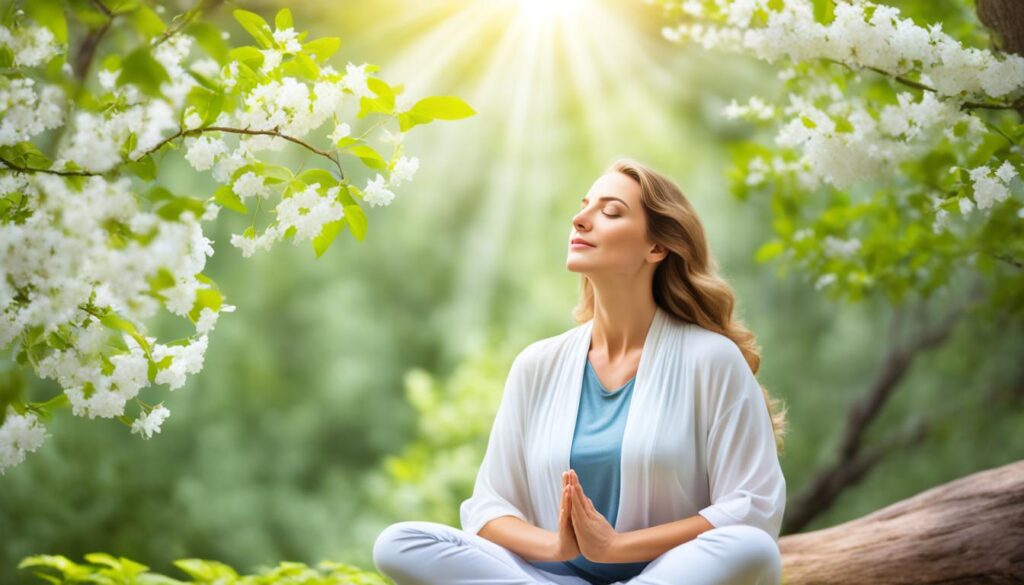
Conclusion
Finding stillness and inner peace is a journey unique to each individual. It is a practice that requires patience, experimentation, and the discovery of what works best for us. By incorporating various techniques, such as deep breathing, embracing spontaneous stillness, and engaging in activities that bring joy, we can cultivate inner peace and find a sense of stillness in our lives.
The practice of stillness allows us to create a calm and peaceful space within ourselves. It gives us the opportunity to self-reflect, soothe our nervous system, and find clarity amidst the chaos of daily life. Through the practice of stillness, we can silence the noise of the external world and tune in to the wisdom and guidance that resides within us.
Remember, the journey towards inner peace is not a destination but an ongoing process. It is a commitment to ourselves and our well-being. As we continue on this journey, let us embrace the power of stillness and the transformative effects it can have on our lives. May we find solace and harmony within, and may our practice of stillness bring us closer to the peace and contentment we seek.
How Can Practicing Stillness Help Maintain Inner Peace During a Divorce?
During a divorce, practicing stillness can help maintain inner peace, especially when dealing with the custody of minor children. Taking time for quiet reflection allows for better decision-making and reduces stress. It also helps in focusing on what truly matters and navigating the emotional challenges more effectively.
FAQ
How can I practice stillness for inner peace?
There are several ways to practice stillness for inner peace. Some effective practices include creating an intention of stillness, focusing on what is within your control, taking slow, deep breaths, finding a favorite stillness spot, embracing spontaneous stillness, using music and calming phrases for structure, quieting the mind and focusing on the present moment, reflecting on the past to work through experiences, letting go of external comparisons, nurturing meaning and purpose, engaging in joyful activities, and prioritizing self-care.
How can deep breathing help in finding stillness?
Deep breathing is a powerful tool that can help induce the parasympathetic system, leading to a slower heart rate and a sense of calm. By taking slow, deep breaths, you can activate your body’s relaxation response, which can aid in finding stillness and calming your mind. This practice can be done anywhere and at any time you need it.
How can I practice spontaneous stillness?
Spontaneous stillness can be practiced regardless of your location. Taking a few minutes for yourself in the middle of the day, whether in your office or any other place, can help you cultivate stillness. If spontaneous stillness doesn’t come naturally to you, you can schedule it and make it a priority in your life. By carving out dedicated time for stillness, you can create space for peace and tranquility.
Where can I find my favorite stillness spot?
Your favorite stillness spot can be anywhere that brings you joy and silence. It can be a park, a quiet bench, or a peaceful corner at home. Find a place that resonates with you and allows you to disconnect from distractions. Being in a place that brings you happiness and peace can enhance your ability to find and cultivate stillness.
How can music and calming phrases help in practicing stillness?
Some people may find creating more structure helpful when practicing stillness. Listening to soft, slow music or repeating calming phrases can provide a sense of direction and support your journey towards inner peace. These practices can help quiet the mind and create a soothing environment for stillness.
What is the importance of stillness of the mind?
Stillness of the mind is crucial in finding inner peace. By quieting the mind and focusing on the present moment, you can cultivate a sense of stillness. Letting go of distracting thoughts and practicing non-judgmental awareness can help you create a calm and tranquil mental state. Stillness of the mind allows for self-reflection, clarity, and a break from the constant noise of daily life.
How can stillness of the spirit help in finding inner peace?
Stillness of the spirit involves honest reflection and an examination of the past. It allows you to work through past experiences, question your beliefs, and grow into your best self. By engaging in this inner work, you can find stillness and inner peace. Embracing stillness of the spirit can lead to personal growth, healing, and a deep sense of contentment.
Why is letting go of external comparisons important in finding inner peace?
Comparing ourselves to others and focusing on external measures can hinder our ability to find inner peace. By letting go of external comparisons and embracing self-acceptance, we can cultivate stillness and contentment. Practicing gratitude and recognizing that true happiness comes from within can help shift our focus away from external measures of success and contribute to a sense of inner peace.
How does nurturing meaning and purpose contribute to stillness?
Having a sense of purpose and meaning in life provides a sense of direction and focus. This can help you make decisions that align with your values and contribute to a sense of inner peace. Connecting with something larger than yourself, whether it’s through meaningful work or personal relationships, can bring a sense of connection and calm. Nurturing meaning and purpose can bring a sense of fulfillment and enhance your journey towards stillness.
How can engaging in joyful activities help in cultivating stillness?
Engaging in activities that bring you joy and fulfillment can shift your focus away from stress and negativity. By prioritizing activities that bring you happiness and finding satisfaction in them, you can cultivate inner peace and contentment. Whether it’s pursuing a hobby, spending time in nature, or connecting with loved ones, finding joy in the present moment can lead to a sense of stillness and tranquility.
Why is prioritizing self-care important in finding stillness and inner peace?
Practicing self-care is essential for finding stillness and inner peace. Taking care of your physical, emotional, and mental well-being allows you to feel grounded and at ease. By prioritizing self-care, you can manage stress, maintain balance, and cultivate a sense of calm and clarity. Engaging in activities that nourish your body and mind, such as exercise, mindfulness practices, and setting boundaries, can support your journey towards stillness.
What is the key to finding stillness and inner peace?
Finding stillness and inner peace is a unique journey for each individual. It requires patience, experimentation, and finding what works best for you. By incorporating practices such as deep breathing, spontaneous stillness, engaging in joyful activities, and prioritizing self-care, you can cultivate inner peace and find a sense of stillness in your life. Embrace the process and allow yourself the space and time to discover what brings you peace.

